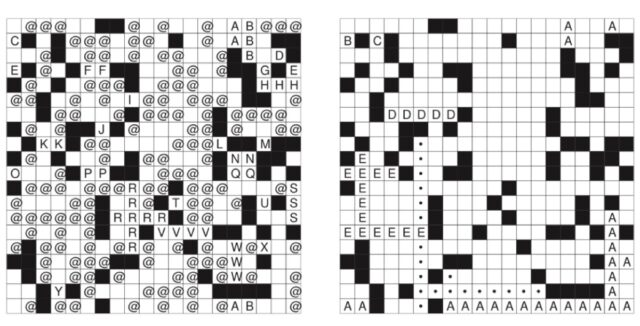There’s also the more recent concept of “explosive percolation,” whereby connectivity emerges not in a slow, continuous process but quite suddenly, simply by replacing the random node connections with predetermined criteria—say, choosing to connect whichever pair of nodes has the fewest pre-existing connections to other nodes. This introduces bias into the system and suppresses the growth of large dominant clusters. Instead, many large unconnected clusters grow until the critical threshold is reached. At that point, even adding just one or two more connections will trigger one global violent merger (instant uber-connectivity).
Puzzling over percolation
One might not immediately think of crossword puzzles as a network, although there have been a couple of relevant prior mathematical studies. For instance, John McSweeney of the Rose-Hulman Institute of Technology in Indiana employed a random graph network model for crossword puzzles in 2016. He factored in how a puzzle’s solvability is affected by the interactions between the structure of the puzzle’s cells (squares) and word difficulty, i.e., the fraction of letters you need to know in a given word in order to figure out what it is.
Answers represented nodes while answer crossings represented edges, and McSweeney assigned a random distribution of word difficulty levels to the clues. “This randomness in the clue difficulties is ultimately responsible for the wide variability in the solvability of a puzzle, which many solvers know well—a solver, presented with two puzzles of ostensibly equal difficulty, may solve one readily and be stumped by the other,” he wrote at the time. At some point, there has to be a phase transition, in which solving the easiest words enables the puzzler to solve the more difficult words until the critical threshold is reached and the puzzler can fill in many solutions in rapid succession—a dynamic process that resembles, say, the spread of diseases in social groups.

In this sample realization, black sites are shown in black; empty sites are white; and occupied sites contain symbols and letters.
Credit:
Alexander K. Hartmann, 2024
Hartmann’s new model incorporates elements of several nonstandard percolation models, including how much the solver benefits from partial knowledge of the answers. Letters correspond to sites (white squares) while words are segments of those sites, bordered by black squares. There is an a priori probability of being able to solve a given word if no letters are known. If some words are solved, the puzzler gains partial knowledge of neighboring unsolved words, which increases the probability of those words being solved as well.
Article by:Source Jennifer Ouellette


















